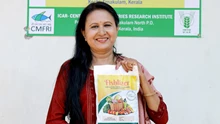
Sweetness meets sublime when Alphonso mangoes come to mind. It reigns supreme like a golden crown atop the fruit kingdom. Picture this: a sun-kissed orchard nestled in the lush Konkan region of India, where the mangoes ripen under azure skies and whisper secrets of exotic allure.
With a skin-like velvet and a fragrance that dances on the breeze, the Alphonso seduces the senses before it even touches the lips. But its true magic lies within, where each succulent bite bursts forth a symphony of flavors—honeyed nectar mingling with notes of apricot and citrus, leaving a lingering euphoria that ignites the soul.
Renowned for its buttery texture and low fiber content, it is not merely a fruit but an experience that transports you to a paradise of pure bliss with every tantalizing taste. So, don’t let con masters fool you this season. Here is how you can identify real from fake Alphonso mangoes.
According to Mohd. Husain Dhanshe who owns Dhanshe Farms in Maharashtra, “The color and taste are fundamental factors in being able to differentiate between real and fake Alphonso mangoes. Notably, the look and feel of the mangoes will depend on the region it has grown in such as in Karnataka or Maharashtra etc. These areas boast different textures and flavors, based on the soil the fruits have grown in. The quality of the Ratnagiri is the most supreme.”
He continues, “Many times, people prefer to select mangoes based on the price than its quality. So, after April 15, if someone is selling you cheap mangoes, then know that it may not be worth consuming. Think twice before making such choices. The creamy yellow texture of mangoes and light spotting is preferable; ensure to buy from a trusted dealer.”
Moreover, the expert suggests soaking the mangoes in water to get rid of pesticides. “If a mango is looking completely clean, it may not be organically produced,” he says.
Expressing a similar view, Omkar Sapre, another Alphonso farmer opines that Alphonso is not a natural variety. “It stems from grafting experiments which means that one cannot plant the seeds and grow the plant. Moreover, it has a specific quality – if multiple grafts are performed from the same mother plant, it takes the quality of that area.”
Hence, to be able to spot a fake variety this season, try to smell the mangoes you purchase. “A fake Alphonso will lack the aroma. Several traders in the season take undue advantage of people’s lack of knowledge and label any variety as Devgad or Ratnagiri to get a bigger profit margin. Remember, that Devgad will have a round appearance with orangish insides while the Ratnagiri will appear more yellowish inside.”
Finally, ensure to wash the mangoes before eating and spread the word about the right Alphonso mangoes. “Think and reflect before you purchase it,” cautions Sapre.










